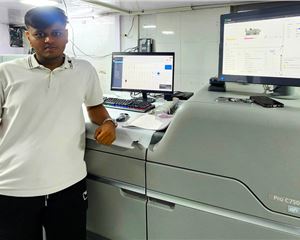Exhibitors Speak: PS Ravishankar, Printronics
At Labelexpo India 2016, Chennai-based Printronics, which represents Durst in India, is showcasing the company’s digital UV inkjet label press, Durst Tau series. The Tau was launched at Drupa 2012, upgraded with a range of versions and configuration options over the years. PS Ravishankar of Printronics explains the fine prints.
18 Nov 2016 | By PrintWeek India
What is your star product at Labelexpo India 2016?
The Durst UV industrial inkjet printing solution for labels, foils and packaging.
Can you explain what’s new in the machine and how will it benefit the customers?
The Durst is now available with low migration ink, which is highly beneficial for food and pharma labels and packaging products.
In terms of functionality, has the role of labels increased or is it still a piece of decoration? How does your press help enhance functionality of labels?
Labels not just convey messages or it is just a piece of decoration. They provide information about products, serve as advertising medium, encourage interaction and help ensure a steady flow of goods. Labels are part of the packaging and of the product. Therefore, high standards are applied to the print, quality, resistance and functionality. With the UV inkjet technology, Durst provides the required flexibility to produce fast, efficient and high print quality for the complete range of applications. Primarily, small and medium runs are profitable with Durst digital systems. With the benefit of low migration inks, the Durst solutions will find acceptance in pharma and food segment.
New guidelines for product security and ingredients disclosures are being introduced on a regular basis. Do you see labels donning a bigger role here?
Yes. With new rules and regulations in force, transparency of details of ingredients and other aspects has become mandatory.
There are new substrates, liner-less to name one, plus processes. Which are the ones that are especially challenging when printing on your presses and what should the labellers do to address these challenges?
The Durst UV inkjet digital press is flexible when it comes to substrate acceptability. Durst can print on a wide range of label stock with or without liners.
Do we see smart labels like temperature-sensitive or colour changing becoming mainstream? These would require special inputs in terms of inks and substrates. Are your presses capable of meeting these requirements?
Yes.
Label printers in India do tricky jobs, printing halftone with 175# and density of ‘two’ with the same plate and same anilox roller. Digital printing machines are different, but are they capable of doing such print jobs?
Durst digital presses are direct imaging. We can print halftone at particular screen ruling and varied density on the same job. There are different profiles to do this with stochastic screens.
One of the ways of becoming profitable is by reducing cost. Does Durst help labellers achieve that?
We strongly believe in the adage, ‘money saved is money earned.’ Compared to other digital solutions available in the industry, the setup time and wastage is very less in Durst digital press. Moreover, ink and other consumable cost are competitive in Durst.
New technologies in pre-press and finishing, substrate and inks are enhancing the functionality of labels. In future, what improvements can we expect from digital presses?
Digital presses will now focus on achieving closest pantones shades, extended colour gamut, further reduction in consumables costs and solutions for metallic colours.
What’s the ‘next big thing’ you see coming in the label segment?
Many innovations are already in place. Now, these innovations will get stabilised with further improvement with the help of workflows. We are already seeing the transition period of flexo press manufacturers getting into UV digital and over the period of time UV inkjet will become the industry standard.












 See All
See All